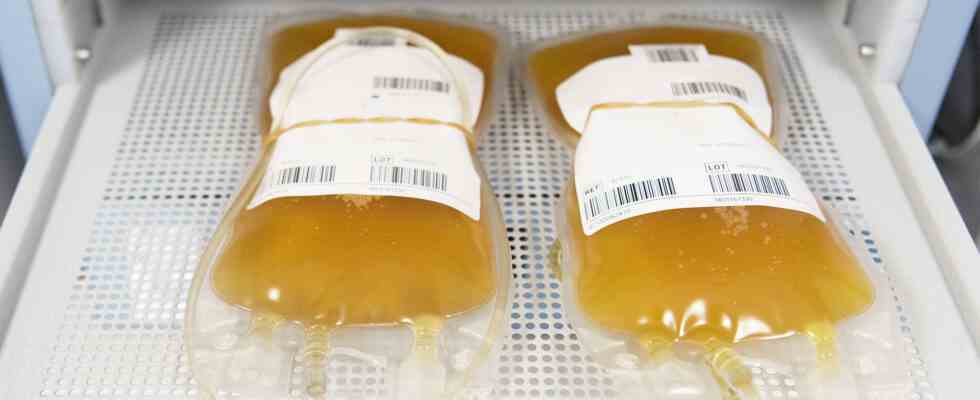Exclusive
Status: 07/14/2022 11:00 a.m
Blood plasma is used for many medicines. Around two-thirds of global demand comes from the USA – where many Mexicans donated plasma for money. That is now forbidden. Pharmaceutical companies are suing.
The extent of paid tourism to the US-Mexico border was far greater than previously known: plasma from Mexican blood donors accounted for up to 10 percent of the total volume produced in the United States and 6 percent of the world’s plasma donations. This is shown by court documents from the USA, which dem NDR and “ProPublica”.
The two media reported in 2019 that pharmaceutical companies lured at least 10,000 Mexicans across the US border every week to sell their blood plasma there. Plasma that also ended up in Germany to be processed into medicines here. The donors were often financially dependent on payment and risked their health due to the high frequency of donations. It is now clear that there were many more.
“Mexican donors are particularly loyal and selfless”
According to court documents, a senior executive at Spanish pharmaceutical company Grifols says that in the centers operated by Grifols in Texas alone, “some 30,000 Mexicans [jährlich] about 600,000 liters of plasma”. Grifols runs 18 donation centers in Texas, and there are more than 50 centers along the border. “Mexican donors are particularly loyal and selfless,” he said in his statement. Grifols told the reporters the importance of the Downplaying border centers and always stressing that most donation centers are far from the border, a senior Grifols official has now conceded NDR and “ProPublica” stated that a total of around three million liters of plasma were missing as a result of the ban a year ago.
Around 5.5 million liters of blood plasma came to Germany from the USA in 2020, also from the border region, mainly because large pharmaceutical companies process the plasma here – for the domestic market and for renewed export. This can be used to produce medicines against chronic immune diseases, for cancer therapy and for emergency medicine.
Thousands of Mexicans have commuted to the United States to donate plasma in recent years.
Donations in Germany are falling
Around two-thirds of the world’s blood plasma, on which Europe depends heavily to meet the ever-growing need for the drugs, is obtained in the United States. While the Council of Europe has so far suggested that donors should donate plasma 33 times a year and Germany allows up to 60 donations, a US donor is allowed to donate twice a week, i.e. 104 times a year. Unlike in Germany, there is no doctor permanently on site in US donation centers and central blood values of the donors are checked much less frequently. In Germany, the number of donations for blood and plasma is falling steadily.
After the release of NDR, SWR, “SZ” and “ProPublica”, the US border protection agency had sent out an internal guideline that effectively declared donation tourism at the border with Mexico to be banned in June 2021 and brought it to a standstill. Grifols and the Australian company CSL sued against it, lost in the first instance and achieved in the second instance that their appeal was allowed. Now the case is back in a Washington court to decide whether Mexican donors will be allowed to cross the border again in the future.
Screenshot of a Facebook ad promoting blood plasma donations in the United States. Up to $1,000 is promised.
Image: Screenshot Facebook
Up to $1000 monthly for new plasma donors
The Plasma Protein Therapeutics Association (PPTA), which represents many pharmaceutical companies, is now arguing differently to the US courts than it has been to journalists. In 2019, the company said in a statement to the NDRthat some donation centers “happily fall within areas defined as border zones”. Don’t have access to donation numbers.
A statement to the court now states that a “center in the border region receives an average of 31 percent more plasma than an average center in the rest of the country”. Since the ban, the centers have recorded between 20 and 90 percent fewer donations, as figures from twelve donation centers would show. In one case, a center now collects about 200 donations a week instead of 5,000, PPTA President Amy Enfantis said in her statement in court. Facebook advertising by the companies shows that new plasma donors are now offering up to USD 1,000 a month, compared to around USD 400 in 2019.
“They only used us”
The court documents also confirm that the fundraising centers are far from randomly located in the frontier, but were part of “strategic efforts” targeting Mexican donors. A memo from the companies’ lawyers said the companies “have spent millions of dollars over the past few years on advertising to encourage Mexican citizens to donate plasma for money at one of the centers on the border.” Donating blood and plasma for money and promoting it is illegal in Mexico.
Many previous donors are upset with the existing ban. “Now I guess we’re not heroes saving lives anymore,” said a comment on a Grifols company page on Facebook, which was later deleted. “They only used us”. Others are relieved that the legality of the marginal donation is now being clarified.
Genesis, a 23-year-old student from Ciudad Juarez, Mexico, said NDR and “ProPublica” that she would support clear rules and was very afraid at the border because it was not clear whether donations for money were legal in the USA. So far, border guards have decided on a case-by-case basis whether Mexicans with visitor visas are allowed to cross the border for this purpose.
The head of a fundraiser, who asked not to be named, said he very much hopes the ban will be lifted. He had laid off about two-thirds of his employees and had to reduce opening hours. “People are dependent on this thing, on both sides.”

